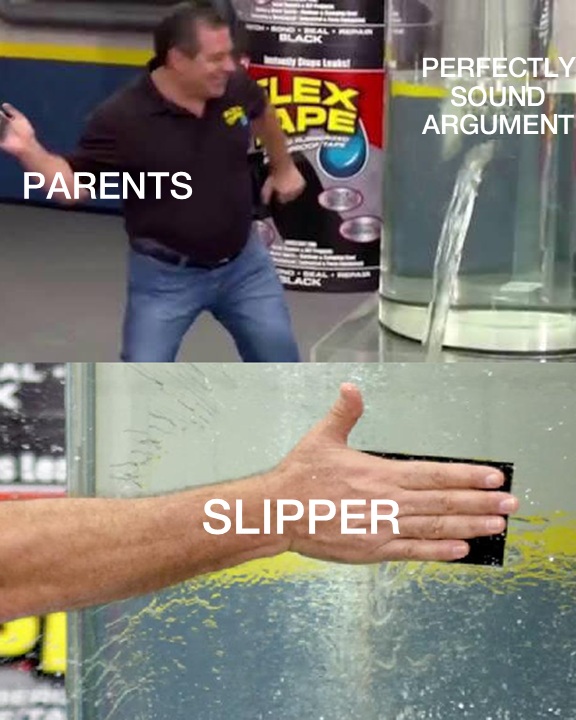Tsinelas: The Filipino Symbol of Discipline and Punishment
It’s Sunday.
My grandma has a slipper in her hand, trying to reach a spider on the wall – to kill it.
This is a scene I haven’t seen in years, yet it’s so humorously familiar to me. Just imagine an old lady in a patterned duster, her face scrunched up, back bent over, briskly walking while fiercely wagging a slipper over her head…..haha!
In my childhood, though I only have happy memories of it, I was no stranger to corporal punishment. I would get spanked in the bum when I answered back. Sometimes, even worse, I’d get threatened with a belt if I lied or fought with my sister.
Over time, this happened less frequently (my youngest sister never knew the same experiences) but I wonder if there were larger social factors that led to the gradual placidness of my parents because on top of this, I noticed that this time was directly congruent with when my parents started speaking less to me in Filipino and more in English.
Fairly recently, a friend of a friend overheard a Chinese resident in his apartment building talking about how they think Filipinos are “bananas”: Yellow on the outside, white in the inside – Asian by appearance but aligning with Western ideals like human rights and democracy. The Philippines has always been a melting pot of Chinese, Spanish and American influence, but perhaps some gradual inclination to more Western ideals was a factor in my observation, at least in my household.
According to a study done in Far Eastern University in 2011, about 74 % of Filipino parents reported using physical punishment in a given month. This meant spanking and slapping extremities with the hand or an object. The analysis also revealed that more boys than girls were physically punished, with mothers being the main perpetrators. The tendency of Filipino parents to punish sons more harshly than their daughters could be a reflection of how boys and girls are regarded in Philippine society. Harsher physical discipline would supposedly mold sons to be stronger pillars of society.
The prevalence of corporeal punishment in the domestic space may also be attributed to Philippine law allowing it as it’s deemed to sometimes be necessary for character formation. This is reflected in Article 45 of Presidential Decree No. 603, known as ‘The Child and Youth Welfare Code’ (Article 45, PD 603).
Now, I don’t know if many parents still hit their children, but I at least still see mothers threatening their kids with slippers in the streets. I suppose that over the decades, we’ve been so well-conditioned to fear it that sometimes mothers pretend to take their slipper off their feet just for the scare. What I personally find funny is that mothers no longer need to actually touch their slipper. Sometimes the simple sudden movement of bending forward and reaching towards the foot already incites a sudden adrenaline and cortisol rush in their children.
For the record, using slippers as a disciplinary tool is also prevalent in Arab, Russian and Hispanic cultures, but in many other countries, corporeal punishment is now considered illegal; I suppose this is something many Filipinos don’t appreciate.
What I find interesting is the fact that those who grew up under the reign of the tsinelas actually consider it to be a thing to laugh about.
There’s a Youtube video from 2013 called “The Secret of La Chancla”, which humorously demonstrates the traditional disciplinary technique and why Hispanic children are “so well-behaved”. In it, the infamous slipper is seen flying across rooms, curbing bad behavior by hitting kids on the head.
Screenshots from “The Secret of La Chancla”.
With millions of views, the video has generated passionate discussions and debates among people with different backgrounds with different views regarding the topic.
However, the aspect of corporeal punishment I find most interesting is the casualness, even sentimentality or nostalgia, with which it’s discussed in cultures where it’s prevalent, tying us to family, friends and strangers with common experiences internationally, despite it clearly being psychologically damaging, according to studies. As Mary L. Pulido, Executive Director of The New York Society for the Prevention of Cruelty to Children, puts it,"Nothing is learned and so much is lost."
Throughout my childhood, I was no stranger to rubber slippers and sometimes thick belts used by my parents to discipline me and my sister. I used to be terrified by these objects (in context), but even though I’m not Hispanic, I resonate so much “The Secret of La Chancla” due to my upbringing that when I first saw the video, I caught myself laughing out loud.
Lisa Fontes, Ph.D., lecturer and author of Child Abuse and Culture: Working with Diverse Families, sees the laughter as a sort of coping mechanism. In an email, she wrote, "I think people from all groups joke about the punishments they've received because it is a way to cope with ambiguous feelings, trying to make sense of the love and loyalty they feel toward their parents, today, and also the shame, fear, and humiliation they felt when young."
In defense of our parents, it’s not that their intentions were really to damage our psyche or self-esteem. It was more of a matter of tradition, applying the same disciplinary methods their own parents used. But as we grow increasingly aware of the harmfulness of physical punishment and learn about fairer ways of dealing with children, it would serve us well to question what, so ingrained in our cultural fabric, we’ve long accepted as normal.



